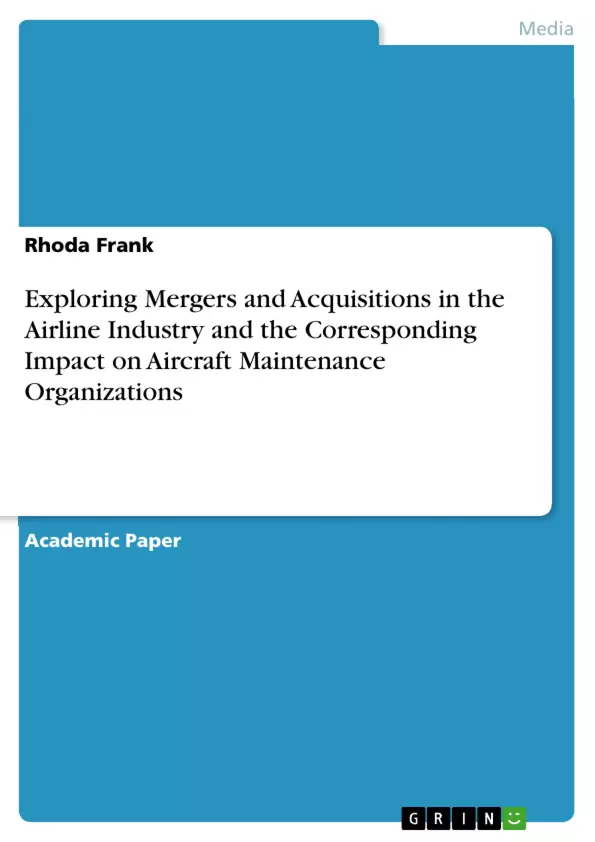This study was conducted to explore mergers and acquisitions in the aviation industry and the corresponding impact on supply chains. The problem statement: Merger and Acquisitions are a common theme in the airline industry. However, due to a lack of proper planning and integration of the supply chain process during the negotiation stage, supply chains involving the two companies are negatively affected. It is therefore important to find ways through which supply chain processes are integrated to ensure a smooth transition period after the merger or acquisition. The objective of the study: To determine the impact of mergers and acquisitions on supply chains in the aviation industry. The study follows a qualitative nature with an analysis of literature and a case study of a merger. The results indicate that there is a challenge in the supply chain after the consolidation of two companies. The study recommends that Continuous supply chain integration monitoring is required to enable timely feedback, allowing corrective measures to be performed and the process to be modified to follow the intended route. This will allow the managers at these companies to evaluate all their processes, and in turn, they will be able to determine areas that need improvement.
Inhaltsverzeichnis (Table of Contents)
- Exploring Mergers and Acquisitions in the Airline Industry and the Corresponding Impact on Aircraft Maintenance Organizations
- Problem Statement
- Intent
- Research Question
- Hypothesis
- Literature Themes
- Data Collection and Analysis Plan
- Results
Zielsetzung und Themenschwerpunkte (Objectives and Key Themes)
This study investigates mergers and acquisitions (M&A) in the airline industry, focusing on their impact on supply chains. The objective is to determine how M&A activities affect supply chain processes and identify challenges that arise during the integration process.
- The impact of M&A on supply chain processes in the aviation industry.
- Challenges associated with supply chain integration after a merger or acquisition.
- The importance of proper planning and integration of supply chain processes during M&A negotiations.
- Strategies to ensure a smooth transition period and minimize disruption after M&A deals.
- The role of supply chain leadership in M&A transactions.
Zusammenfassung der Kapitel (Chapter Summaries)
- Problem Statement: The study highlights the prevalent issue of M&A activities in the airline industry. However, due to a lack of proper planning and supply chain integration during negotiations, supply chains often face negative consequences after the merger or acquisition. The study emphasizes the need for effective integration strategies to ensure a smooth transition.
- Intent: This paper aims to explore the nature of M&A in the airline industry, analyzing the process of takeovers and providing recommendations for best practices. The paper will also focus on mitigating supply chain pitfalls during and after the negotiation process.
- Research Question: The study aims to determine the impact of M&A on supply chains in the aviation industry.
- Hypothesis: The study posits that M&A in the airline industry can potentially cause supply chain problems due to the scale of operations and inadequate planning during negotiations.
- Literature Themes: This section examines the concept of M&A as a business strategy, exploring its potential to expand into new markets and enhance a company's competitive advantage. The discussion highlights the prevalence of M&A in the aviation sector, particularly in nations like China, India, the United States, and France. The section also discusses the challenges associated with M&A, particularly the lack of proper integration of supply chains during the negotiation process.
- Data Collection and Analysis Plan: The study employs a qualitative approach, focusing on the literature surrounding the merger that created the National Aviation Company of India Limited (NACIL). The analysis will involve examining past statements about the merger and acquisition, focusing on the impact of the deal on the supply chain after its completion.
Schlüsselwörter (Keywords)
This study focuses on mergers and acquisitions, supply chain management, aviation industry, integration, challenges, planning, negotiation, case study, National Aviation Company of India Limited (NACIL), Air India, Indian Airlines, qualitative research, literature review.
- Quote paper
- Rhoda Frank (Author), 2023, Exploring Mergers and Acquisitions in the Airline Industry and the Corresponding Impact on Aircraft Maintenance Organizations, Munich, GRIN Verlag, https://www.grin.com/document/1363790



